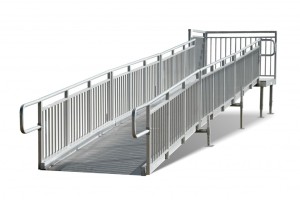Modular school buildings are necessary for many situations. One of these temporary buildings may be necessary while a permanent structure is under construction. Modular buildings are also suitable as replacements for buildings that were damaged in storms or other events. Schools can also order these buildings to cover the rapidly rising school enrollment rates in some areas.
 Each school modular building will require an ADA ramp. The ramp is necessary for allowing people who use wheelchairs and other mobility instruments to reach a modular building. Since these structures are prepared on posts, the entryway will be a few inches or feet off the ground. A ramp will help a wheelchair user reach that entrance. Our workers at REDD Team can help schools by producing these school modular building ADA ramps.
Each school modular building will require an ADA ramp. The ramp is necessary for allowing people who use wheelchairs and other mobility instruments to reach a modular building. Since these structures are prepared on posts, the entryway will be a few inches or feet off the ground. A ramp will help a wheelchair user reach that entrance. Our workers at REDD Team can help schools by producing these school modular building ADA ramps.
How Will a Ramp Look?
The design of your ADA ramp can vary over the layout of your modular building. A structure where the entry door is on a far side can use a simple ramp that goes in one direction. A building where the door is in the middle will require a ramp that includes a turning space midway through. The turning spot should have support for a 60-inch turning radius.
Regardless of the design, the ramp will require a safe slope that allows a wheelchair user to go up and down well. There should be a 60-inch landing on both ends of the ramp to allow the wheelchair user to get to the door while also supporting the turning radius.
What About Guardrails?
A ramp with a rise of six inches or greater will require a guardrail. Since modular buildings will have openings that go well above six inches, you’ll require guardrails for your ADA-compliant ramps. These handrails must also be from 34 to 38 inches high while staying continuous along the ramp’s complete length.
How Is the Ramp Installed?
You can get your ramp installed by using a series of anchors that will keep the ramp in its place on the ground. The ramp can also be affixed to the main body of your modular building through bolts and other fasteners. The design should be strong enough to where the ramp will stay in place. There should be enough anchors all around to help you keep the ramp in place, which is critical when looking at how the ground can shift in some spaces after a storm.
How Much Weight Can a Ramp Handle?
ADA standards require a wheelchair ramp to handle at least five times the anticipated weight it might handle. The weight of a wheelchair can vary, with some electric models weighing at least a hundred points, so having a ramp that can handle enough weight will be critical. ADA standards also state that the absolute minimum that a ramp can hold should be 1,000 pounds, so finding a material that can handle all that weight is critical. An aluminum ramp like what we at REDD Team can produce will meet this standard.
Ask us at REDD Team if you’re looking for help building and installing school modular building ADA ramps. We produce high-quality aluminum ramps in the United States, and we can size our ramps based on your unique needs. Contact us online or by phone at (800) 648-3696 if you require further help with your building needs.

